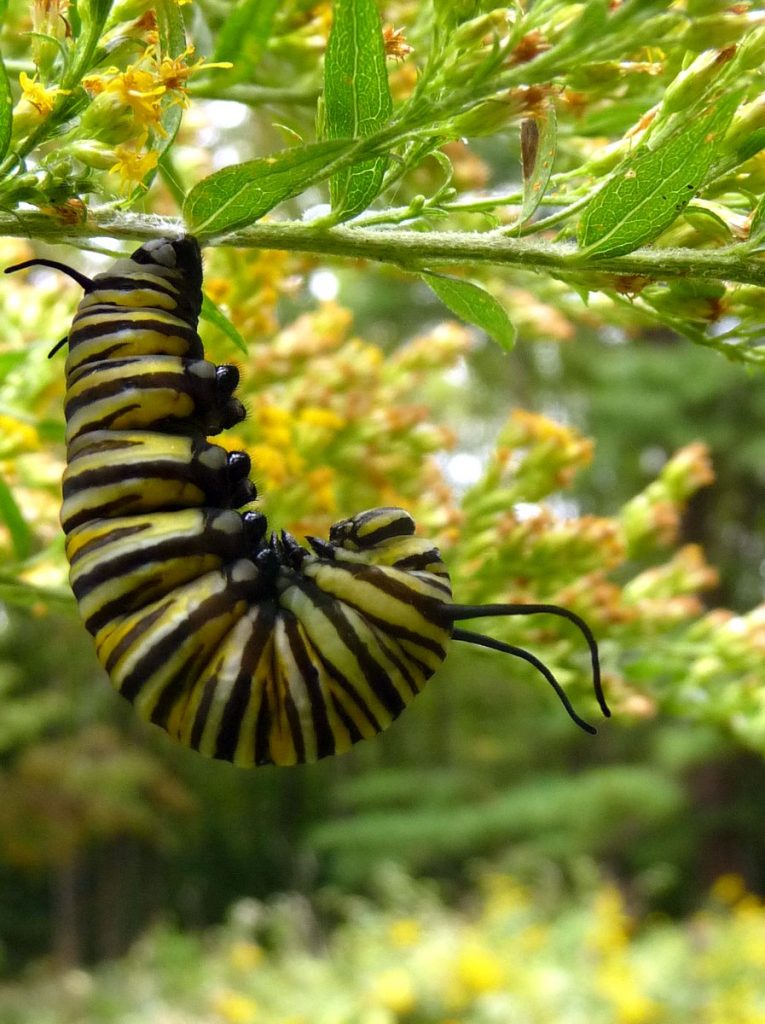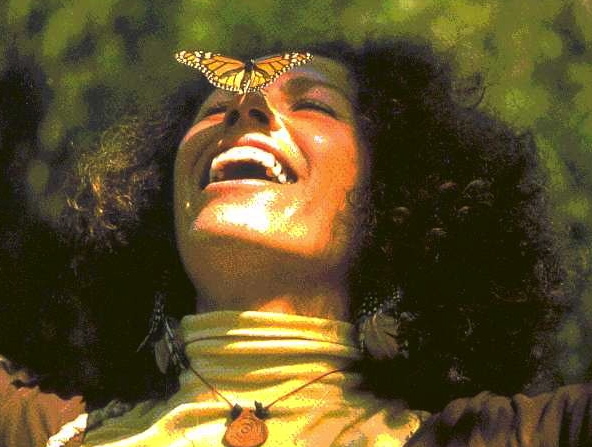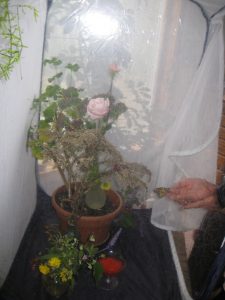It takes a village to keep the Monarch migration going. That’s surely the case for “Butterfly Lady” Maraleen Manos-Jones, one female Monarch butterfly, butterfly researchers far and wide, a USDA inspector, Southwest Airlines and the San Antonio Botanical Garden.
In South Texas, Monarch butterflies continue laying eggs, hatching caterpillars, and forming chrysalises well into November. In fact, several caterpillars are noshing on milkweed leaves in my kitchen as I write this. When they emerge from their chrysalises later this month, I’ll tag them and send them on their way to Michoacan where they can join their butterfly brethren for the winter.
But in upstate New York, late season Monarchs are problematic. Maraleen Manos-Jones, author of The Spirit of Butterflies, lives in Shokan, New York, about 100 miles north of the Big Apple. She noticed a Monarch caterpillar forming its chrysalis in her butterfly garden on September 22.

This caterpillar, as a butterfly, flies Southwest Airlines. The critter formed its chrysalis on Sept. 22 in upstate New York. –photo via Maraleen Manos-Jones
“Most adult monarchs had already started their southward migration,” Manos-Jones relayed via email. By early October, the weather turned cold and she brought the chrysalis indoors. On October 20th, a beautiful female Monarch butterfly emerged.
Often, late season Monarchs that remain in the chrysalis for more than two weeks can emerge with deformed wings. Not this girl. “She was a perfectly formed, large, brilliantly colored female,” said Manos-Jones. Manos-Jones kept the Monarch in a net enclosure in her home, providing nectar from late season flowers from her gardens.
She hoped the Monarch could reunite with its sibling butterflies, but if released in upstate NY in October with temperatures in the 40s, the butterfly would perish. “Butterflies can’t fly when the temperature is less than 55,” said Manos-Jones, adding that cold weather, a lack of nectar sources, and then Superstorm Sandy made for complications.
What to do? Manos-Jones called Southwest Airlines to ask them to fly her and the Monarch butterfly south. “The whole idea came to me slowly and organically,” said Manos-Jones. “There were many phone calls.” Manos-Jones was passed to the Southwest Airlines PR department. “I spoke from my heart,” she said. “They also checked out my ‘butterfly credentials.'”
A self-described performer, artist, educator and environmentalist, Manos-Jones has butterfly street cred to spare. Smitten at an early age, she once camped with the Monarchs in Michoacan for weeks in the 70s, trying to find the location of the ancestral roosts along with cowboy entomologist Dr. Bill Calvert. She has raised Monarchs for 40 years, been involved in Monarch conservation for decades, and currently serves on the Board of Directors of the La Cruz Habitat Protection Project, Inc. and Forests for Monarchs. She also offers butterfly garden consulting, butterfly tours, and in safer times, Monarch butterfly tours to Michoacan.
Ultimately, Southwest agreed to comp the 1950-mile flight for Manos-Jones and her precious cargo, from Albany, NY, to San Antonio, TX. Southwest even assigned an on-flight escort to fly with Manos-Jones and record the trip. Upon arrival in San Antonio, a Southwest Airlines video crew will be on hand to document the event.
Brooks Thomas, the PR representative for Southwest Airlines that arranged the “butterflight,” said it was impossible to say no to Manos-Jones. “She’s pretty passionate,” he said.
“Maraleen is an original,” said Dr. Chip Taylor, founder of Monarch Watch. “She’s one of a kind.” Taylor advised Manos-Jones that transporting butterflies across state lines is illegal without a permit from the USDA, and put her in touch with government agent Wayne Wehling. Wehling works with butterfly breeders and others regarding the legal moves of plants and insects around the country. Manos-Jones will be in compliance, traveling with her permit.
Her butterfly will be safely ensconced in a glassine envelope provided by Dr. Lincoln Brower, one of the foremost researchers of Monarch butterflies in the world. She’ll keep the butterfly calm, cool, in the dark, in a container lined with an ice pack and plenty of cushioning.
WHAT: Release of Monarch Butterfly from New York WHERE: San Antonio Botanical Garden The San Antonio Botanical Garden 555 Funston @ North New Braunfels Avenue San Antonio, TX 78209 WHEN: 3:30 p.m., Monday, November 5, 2012 WHY: We want it to have a chance to make it to Mexico HOW CAN YOU HELP: Plant milkweed, the Monarch butterfly host plant
The San Antonio Botanical Garden’s butterfly garden will be the stage for the release, with ample milkweed, asters, and other late season bloomers providing a nectar-filled backdrop for a successful release.
If you’d like to join us, the release will take place at 3:30 PM Monday, November 5. Regular Botanical Gardens admission charges will apply.
Like what you’re reading? Don’t miss a single article from the Texas Butterfly Ranch–subscribe at this link. Also, like us on Facebook, follow us on Twitter, @monikam or on Instagram.



Wow! Love the butterflight! Thanks, Southwest!
Don’t know if I’ll be able to make it from Austin, but will do my best.
It’s actually in San Antonio. Please come join us!
–MM
I found a monarch here in Kentucky with deformed wings that emerged from her chrysalis in late October.
(The story:) https://youtu.be/gDIMO4ph_c4
I’m planning to try and fix her wings like I’ve seen some people do successfully. However, it’s also sort of late in the season, so even if she can fly afterward, I’m afraid she won’t make it to Mexico. One of my friends is flying on an airplane there in December, and after hearing this story, it made me wonder if it would be better to send her with them…. I don’t know what to do. Please, what do you think is the best option?
Very cool! Wish I could join you. Bravo to Southwest for having the acumen to see what a win-win situation this is. Ken
This story gave me goosebumps!! Good for you!!
My son didn’t understand why I was so upset when my foster caterpillar died. He said “momma it’s only one caterpillar!” But I know how precious each one is and I couldn’t help but wonder if it would have been more safe if I’d left it outside. I know that there are more dangers to them outside, but I still felt really sad, not sure if perhaps I harmed him while cleaning out his cage or something of that sort. There aren’t that many coming through here, and it is so unfortunate. I can’t help but wonder if it’s the mosquito spraying that’s doing it.
I enjoyed your post as usual, Monika!
I just heard your story on NPR. BRAVO!
I run a GED program in Holyoke, MA for adults. I am also their science teacher. Last week we watched the NOVA documentary “The Incredible Journey of the Butterfly.” The students were enthralled. They couldn’t stop talking about the butterflies. I printed out your lovely story and will share with them. Maybe Southwest could fly my students to see you! 😉
Thank you for your dedication to these incredible travelers.
Aliza Ansell
PS- I live in Cummington, MA and have dozens of milk weed plants in my field, so I enjoy our light-weight travelers every summer. I never knew the extent of their epic journey until I saw the film! WOW.
Wow!! Such a touching story. My family and I also have a Monarch Waystation in our yard and ‘harvest’ caterpillars. I really appreciate Ms. Jones’ effort for ‘just’ one Monarch. A big THANKS from Texas!
[…] Airlines agreed to allow Maros-Jones to transport the butterfly on a flight to Texas free of charge, according to the Texas Butterfly Ranch. Maros-Jones plans to arrive in San Antonio on Monday […]
Thank you for sharing the information. I went to the release and it was simply beautiful!!
This is our LUV Airlines. No other Airlines would even think of honoring such a request. Thanks SWA for allowing this little Butterfly share its wings with yours.
NO ONE LIKE SWA
Hi Monika,
Thank you for posting this. I attended the butterfly release event yesterday. It was beautiful and touching. Here is a link to my post pertaining to the event: http://ramblingwrentx.blogspot.com/2012/11/monarch-butterfly-takes-trip.html
I understand that there is not a butterfly forum here in SA. Are you interested in forming one?
Let’s do it! I belong to the Austin Butterfly Forum and have spoken to them about collaborating. Now’s the time. –MM
I agree! My email is steph-kw@satx.rr.com. Looking forward to hearing from you soon.
[…] whole idea came to me slowly and organically,” said Maraleen on the blog of the Texas Butterfly Ranch. “There were many phone […]